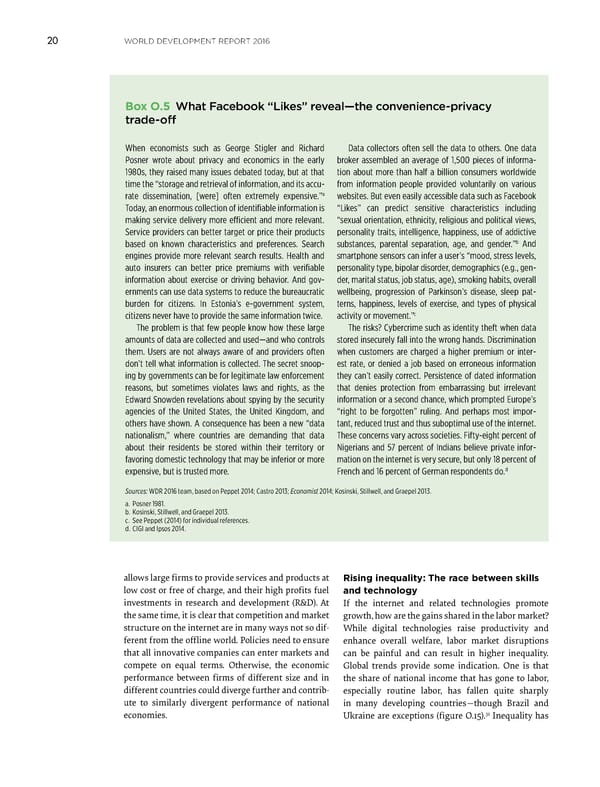WORLD DEVELOPMENT REPORT 2016 20 Box O.5 What Facebook “Likes” reveal—the convenience-privacy trade-off When economists such as George Stigler and Richard Data collectors often sell the data to others. One data Posner wrote about privacy and economics in the early broker assembled an average of 1,500 pieces of informa- 1980s, they raised many issues debated today, but at that tion about more than half a billion consumers worldwide time the “storage and retrieval of information, and its accu- from information people provided voluntarily on various a rate dissemination, [were] often extremely expensive.” websites. But even easily accessible data such as Facebook Today, an enormous collection of identifiable information is “Likes” can predict sensitive characteristics including making service delivery more efficient and more relevant. “sexual orientation, ethnicity, religious and political views, Service providers can better target or price their products personality traits, intelligence, happiness, use of addictive based on known characteristics and preferences. Search substances, parental separation, age, and gender.”b And engines provide more relevant search results. Health and smartphone sensors can infer a user’s “mood, stress levels, auto insurers can better price premiums with verifiable personality type, bipolar disorder, demographics (e.g., gen- information about exercise or driving behavior. And gov- der, marital status, job status, age), smoking habits, overall ernments can use data systems to reduce the bureaucratic wellbeing, progression of Parkinson’s disease, sleep pat- burden for citizens. In Estonia’s e-government system, terns, happiness, levels of exercise, and types of physical c citizens never have to provide the same information twice. activity or movement.” The problem is that few people know how these large The risks? Cybercrime such as identity theft when data amounts of data are collected and used—and who controls stored insecurely fall into the wrong hands. Discrimination them. Users are not always aware of and providers often when customers are charged a higher premium or inter- don’t tell what information is collected. The secret snoop- est rate, or denied a job based on erroneous information ing by governments can be for legitimate law enforcement they can’t easily correct. Persistence of dated information reasons, but sometimes violates laws and rights, as the that denies protection from embarrassing but irrelevant Edward Snowden revelations about spying by the security information or a second chance, which prompted Europe’s agencies of the United States, the United Kingdom, and “right to be forgotten” ruling. And perhaps most impor- others have shown. A consequence has been a new “data tant, reduced trust and thus suboptimal use of the internet. nationalism,” where countries are demanding that data These concerns vary across societies. Fifty-eight percent of about their residents be stored within their territory or Nigerians and 57 percent of Indians believe private infor- favoring domestic technology that may be inferior or more mation on the internet is very secure, but only 18 percent of d expensive, but is trusted more. French and 16 percent of German respondents do. Sources: WDR 2016 team, based on Peppet 2014; Castro 2013; Economist 2014; Kosinski, Stillwell, and Graepel 2013. a. Posner 1981. b. Kosinski, Stillwell, and Graepel 2013. c. See Peppet (2014) for individual references. d. CIGI and Ipsos 2014. allows large firms to provide services and products at Rising inequality: The race between skills low cost or free of charge, and their high profits fuel and technology investments in research and development (R&D). At If the internet and related technologies promote the same time, it is clear that competition and market growth, how are the gains shared in the labor market? structure on the internet are in many ways not so dif- While digital technologies raise productivity and ferent from the offline world. Policies need to ensure enhance overall welfare, labor market disruptions that all innovative companies can enter markets and can be painful and can result in higher inequality. compete on equal terms. Otherwise, the economic Global trends provide some indication. One is that performance between firms of different size and in the share of national income that has gone to labor, different countries could diverge further and contrib- especially routine labor, has fallen quite sharply ute to similarly divergent performance of national in many developing countries—though Brazil and economies. Ukraine are exceptions (figure O.15).31 Inequality has
 World Development Report 2016 Page 33 Page 35
World Development Report 2016 Page 33 Page 35